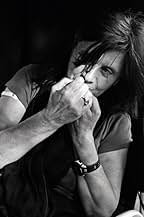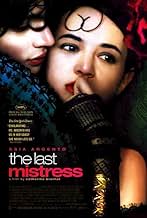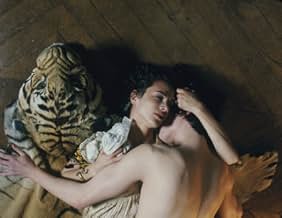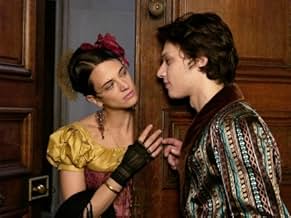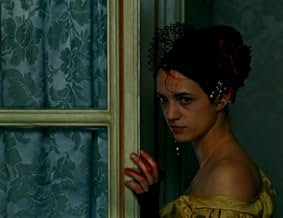IMDb रेटिंग
6.2/10
3.9 हज़ार
आपकी रेटिंग
अपनी भाषा में प्लॉट जोड़ेंSecrets, rumors and betrayals surround the upcoming marriage between a young dissolute man and virtuous woman of the French aristocracy.Secrets, rumors and betrayals surround the upcoming marriage between a young dissolute man and virtuous woman of the French aristocracy.Secrets, rumors and betrayals surround the upcoming marriage between a young dissolute man and virtuous woman of the French aristocracy.
- निर्देशक
- लेखक
- स्टार
- पुरस्कार
- 3 कुल नामांकन
फ़ीचर्ड समीक्षाएं
Breillat's films are mostly small budget contemporary provocations with a feminist bent. This one, her twelfth, she says cost as much as ten previous ones and is a costume drama based on a controversial novel by Jules-Amédée Barbey d'Aurevilly (1808-1889). This is a bit confusing: the film begins by saying it's the century of Choderlos de Laclos (author of Dangerous Liaisons). but his famous work was written in 1782, and the action of d'Aurevilly's novel is set in 1835. The point is, the story is about the French aristocracy, and in the early nineteenth century its members still believed in and lived by the libertinism of Laclos.
In fact The Last Mistress (Une vieille maitresse) is a transitional story that links the two centuries and in a sense presents a romantic conception of the eighteenth century. Ryno de Marigny (beautiful newcomer Fu'ad Ait Aattou) is a high born young man who has squandered his wealth on his Spanish mistress, the willful Vellini (Asia Argento, in her element), with whom he's been involved for ten years. Allocine calls Ryno "a kind of romantic Valmont." But that's just it: there was nothing romantic about de Laclos' cruel and manipulative Valmont and Ryno is a new post-eighteenth-century conception of the eighteenth-century libertine that is titillated by his freedom but adds the emotional dressing of romantic passion. Breillat obviously loves this combination, is at home with it, and has given it deliriously appropriate treatment in this minor but beautiful, lush, and thoroughly enjoyable film.
The Breillat touch is perhaps most visible in the love-making scenes between Vellini and Ryno, in which there is much nudity and specificity of physical detail. Fu'ad Ait Aattou has pale skin and bigger lips than Asia Argento. By intention, both are androgynous; this is Breillat's conception of Choderlos de Laclos's and d'Aurevilly's libertines. The two actors are perfectly matched for this. Vellini is the aggressor; it is she who makes love with Ryno, using him like a lovely male statue made of alabaster. He is passionate like a romantic lover, however: that is, he's hung up on her forever, no matter what he tries. Early on, he fights a duel with her English husband and is wounded in the shoulder. The sex sequences are specific and fleshy as in no other costume drama, but Breillat is not creating an anachronistic work. As she explained in the NYFF press Q&A, she is passionate about the quality of her period detail and bought tons of lush materials and costumes. The dress, the jewelry, and the interiors are all completely authentic, and there is a rich color scheme in which red and green and yellow predominate. Without seeming over-glossy (it's not eye-candy like Sofia Coppola's Marie Antoinette), The Last Mistress is a pleasure to look at. It's also a pleasure to listen to, with its choice use of ornate and witty language. Oldtimer Michael Lonsdale as the gossipy Le vicomte de Prony particularly relishes his well-turned phrases.
As the story gets under way, Ryno has now found a wife, the beautiful young blonde noblewoman Hermangarde (Breillat regular Roxane Mesquida), and he's in love with her, and tired of Villini. Hermangarde's grandmother, the Marquise de Flers (non-actress Claude Sarraute, daughter of novelist Nathalie) is responsible for vetting Ryno, and in a lengthy sequence that's the heart of the film, he confesses to her everything about his relationship with Vellini. After much has been told (and shown on screen) in an amusing moment we see the Marquise reclining low in her seat: she is exhausted, but entranced. She wants to hear every detail. The Marquise is of course, of the older generation--a real Choderlos de Laclos lady. For her, the information that Ryno is a true libertine is proof that he is reliable, not an unknown quantity. And the cards are on the table. He'll do.
Rybno has every intention of having done with Vellini, and in a scene we've observed before his confession, he's made love with her one last time and they've said their adieus and adioses. Afrter his marriage, which we don't see, Ryno and Hermangarde live in a castle by the sea--so that he can avoid the temptations of Paris. Velllini waits four months, and then she appears. And once she is in front of Ryno, despite his professions of being fed up with her, he can't resist her.
There are several scenes in which Vellini draws blood from Ryno and licks it up: hints or Ms. Argento's father's films? Part of the New York Film Festival 2007. Three years after a stroke, Breillat is clearly in fine form--never better--and this is a long-awaited (by her) labor of love.
In fact The Last Mistress (Une vieille maitresse) is a transitional story that links the two centuries and in a sense presents a romantic conception of the eighteenth century. Ryno de Marigny (beautiful newcomer Fu'ad Ait Aattou) is a high born young man who has squandered his wealth on his Spanish mistress, the willful Vellini (Asia Argento, in her element), with whom he's been involved for ten years. Allocine calls Ryno "a kind of romantic Valmont." But that's just it: there was nothing romantic about de Laclos' cruel and manipulative Valmont and Ryno is a new post-eighteenth-century conception of the eighteenth-century libertine that is titillated by his freedom but adds the emotional dressing of romantic passion. Breillat obviously loves this combination, is at home with it, and has given it deliriously appropriate treatment in this minor but beautiful, lush, and thoroughly enjoyable film.
The Breillat touch is perhaps most visible in the love-making scenes between Vellini and Ryno, in which there is much nudity and specificity of physical detail. Fu'ad Ait Aattou has pale skin and bigger lips than Asia Argento. By intention, both are androgynous; this is Breillat's conception of Choderlos de Laclos's and d'Aurevilly's libertines. The two actors are perfectly matched for this. Vellini is the aggressor; it is she who makes love with Ryno, using him like a lovely male statue made of alabaster. He is passionate like a romantic lover, however: that is, he's hung up on her forever, no matter what he tries. Early on, he fights a duel with her English husband and is wounded in the shoulder. The sex sequences are specific and fleshy as in no other costume drama, but Breillat is not creating an anachronistic work. As she explained in the NYFF press Q&A, she is passionate about the quality of her period detail and bought tons of lush materials and costumes. The dress, the jewelry, and the interiors are all completely authentic, and there is a rich color scheme in which red and green and yellow predominate. Without seeming over-glossy (it's not eye-candy like Sofia Coppola's Marie Antoinette), The Last Mistress is a pleasure to look at. It's also a pleasure to listen to, with its choice use of ornate and witty language. Oldtimer Michael Lonsdale as the gossipy Le vicomte de Prony particularly relishes his well-turned phrases.
As the story gets under way, Ryno has now found a wife, the beautiful young blonde noblewoman Hermangarde (Breillat regular Roxane Mesquida), and he's in love with her, and tired of Villini. Hermangarde's grandmother, the Marquise de Flers (non-actress Claude Sarraute, daughter of novelist Nathalie) is responsible for vetting Ryno, and in a lengthy sequence that's the heart of the film, he confesses to her everything about his relationship with Vellini. After much has been told (and shown on screen) in an amusing moment we see the Marquise reclining low in her seat: she is exhausted, but entranced. She wants to hear every detail. The Marquise is of course, of the older generation--a real Choderlos de Laclos lady. For her, the information that Ryno is a true libertine is proof that he is reliable, not an unknown quantity. And the cards are on the table. He'll do.
Rybno has every intention of having done with Vellini, and in a scene we've observed before his confession, he's made love with her one last time and they've said their adieus and adioses. Afrter his marriage, which we don't see, Ryno and Hermangarde live in a castle by the sea--so that he can avoid the temptations of Paris. Velllini waits four months, and then she appears. And once she is in front of Ryno, despite his professions of being fed up with her, he can't resist her.
There are several scenes in which Vellini draws blood from Ryno and licks it up: hints or Ms. Argento's father's films? Part of the New York Film Festival 2007. Three years after a stroke, Breillat is clearly in fine form--never better--and this is a long-awaited (by her) labor of love.
Greetings again from the darkness. I always get a kick out of the French cinematic view of love. Of course, there is always some single person we are meant for ... though endless lovers are expected. Somehow there is a soul mate and we always find that person not matter the pain caused to ourself or others.
Director Catherine Breillat uses the transition of France from the late eighteenth century to the early nineteenth as the setting for this tale of "love" among the French upper crust. A cheap plot device - the ultimate detailed confession - provides the full guts of the story, both background and foreshadow.
What made the film inaccessible for me were both lead actors, especially Asia Argento as Vellini (the last mistress). I just didn't find these people likable, whether together or apart. On the other hand, I did enjoy Michael Lonsdale as de Prony, and his wonderful dialogue and delivery.
Mostly an uneventful couple of hours with no surprise ending at all.
Director Catherine Breillat uses the transition of France from the late eighteenth century to the early nineteenth as the setting for this tale of "love" among the French upper crust. A cheap plot device - the ultimate detailed confession - provides the full guts of the story, both background and foreshadow.
What made the film inaccessible for me were both lead actors, especially Asia Argento as Vellini (the last mistress). I just didn't find these people likable, whether together or apart. On the other hand, I did enjoy Michael Lonsdale as de Prony, and his wonderful dialogue and delivery.
Mostly an uneventful couple of hours with no surprise ending at all.
The Last Mistress, a film by Catherine Breillat, director of the hot-n-sexy (and probably X-rated if released in the 1970s) Romance, deals with the torn and frayed and wretched relationship between Vellini (Asia Argento), and Ryno de Marigny (first timer Fu'ad Ait Aattou), and how Ryno's mistress threatens his marriage to Hermandarde (Roxane Mesquida), granddaughter of a tough but very fair and reasonable old matriarch. Breillat's direction of the story, which is mostly told in flashback as the grandmother of her soon-to-be-grandson-in-law tells all about his very turbulent bond with Vellini, is sometimes a little dull and stodgy, and it drags in spots that it really should pick up in high gear.
But damn it all if it's not some absorbing times in the midst of a classic period setting among character we can relish in. Granted, Breillat likely cast Aattou for constantly having a 'sexy-man' look (somewhat akin, if you ask me, of a young Mick Jagger with ridiculously striking eyes and big lips). Argento, on the other hand, is cast perfectly, and for every bit that Aatou and Mesquida don't quite connect as husband and wife it's made up for by the total, hot connection between the real two leads. Argento is right at home with this twisted, damaged but alive and easily emotional creature, who has that tendency in French melodramas for tragedy at any moment just to get a rise. But she's also tender in surprising moments, and lets her soul bare completely in rough sex scenes (the craziest set in the desert following a very sudden death of a character), which par for Breillat are go-for-broke.
What the film may lack in really being a fully "modern" work- it feels like a lot of it is so stuck in the period novel setting that it's locked away, which maybe was the right choice- it's made up for by the stars' appeal and the drive of the torrid love affair that just won't go away. It's appealing, boring, and highly charged in equal measure.
But damn it all if it's not some absorbing times in the midst of a classic period setting among character we can relish in. Granted, Breillat likely cast Aattou for constantly having a 'sexy-man' look (somewhat akin, if you ask me, of a young Mick Jagger with ridiculously striking eyes and big lips). Argento, on the other hand, is cast perfectly, and for every bit that Aatou and Mesquida don't quite connect as husband and wife it's made up for by the total, hot connection between the real two leads. Argento is right at home with this twisted, damaged but alive and easily emotional creature, who has that tendency in French melodramas for tragedy at any moment just to get a rise. But she's also tender in surprising moments, and lets her soul bare completely in rough sex scenes (the craziest set in the desert following a very sudden death of a character), which par for Breillat are go-for-broke.
What the film may lack in really being a fully "modern" work- it feels like a lot of it is so stuck in the period novel setting that it's locked away, which maybe was the right choice- it's made up for by the stars' appeal and the drive of the torrid love affair that just won't go away. It's appealing, boring, and highly charged in equal measure.
This is a beautiful period film with a lot of Breillat's trademark unflinching look at love and war between sexes. The story is old, but this is first time I see it put so frankly - they not marrying the the love of their life....
Sex is shot amazingly. There is an eyeful of historical detail and actors are looking great, dressed and undressed. The book it is based on according to Breillat, is autobiographical, which makes it even more interesting.
To put it simply - great work in many aspects.
Bravo again Catherine!
Sex is shot amazingly. There is an eyeful of historical detail and actors are looking great, dressed and undressed. The book it is based on according to Breillat, is autobiographical, which makes it even more interesting.
To put it simply - great work in many aspects.
Bravo again Catherine!
For years,I pretty much avoided the "face of new Euro porn" films of French director Catherine Breillart (infamous for 'Romance',or 'Romance X',as it was known in Europe). When I heard she had taken on a film adaptation of the 19th century erotic masterpiece, 'The Last Mistress', I though to myself "grand...more boring Euro porn" (I walked out on 'Romance X' out of sheer boredom,and not of shock). Well, I was pleasantly surprised by 'Mistress'. Mind you, Breillart still has some growing up as a writer/director to do (there are things that transpire that are never explained),and her characters are still for the most part, unlikable. Apart from that, she has made some improvements. The cast includes Asia Argento,who doesn't seem to have any issues with tossing off her duds and parading around nude in any film she appears in,as well as several others,including veteran British actor Michael Lonsdale. The plot concerns a penniless,good for nothing young lad who is engaged to be married to a French woman of wealth & name, but has been an off again,on again lover of a half Spanish/half French woman of no certain valor. All I could think at times was 'Dangerous Liasions' meets 'Fatal Attraction',filtered thru a European perspective. This film obviously will not be everybody's cup of tea,but is still worth a look. No rating here,but probably only pull down a hard "R",due to nudity & some fairly restrained sexuality.
क्या आपको पता है
- ट्रिवियाCatherine Breillat discovered Fu'ad Aït Aattou in a Paris café.
- गूफ़While Ryno is descending the stairs at the opera, an Edgar Degas mural can be seen. Degas would have only just been born in this era.
- कनेक्शनFeatured in Metropolis: Cannes 2007 - Special (2007)
टॉप पसंद
रेटिंग देने के लिए साइन-इन करें और वैयक्तिकृत सुझावों के लिए वॉचलिस्ट करें
- How long is The Last Mistress?Alexa द्वारा संचालित
विवरण
- रिलीज़ की तारीख़
- कंट्री ऑफ़ ओरिजिन
- भाषाएं
- इस रूप में भी जाना जाता है
- Metres
- फ़िल्माने की जगहें
- Île de Bréhat, Côtes-d'Armor, फ़्रांस(Moulin du Birlot: Vellini's house in Brittany)
- उत्पादन कंपनियां
- IMDbPro पर और कंपनी क्रेडिट देखें
बॉक्स ऑफ़िस
- बजट
- $60,00,000(अनुमानित)
- US और कनाडा में सकल
- $7,85,671
- US और कनाडा में पहले सप्ताह में कुल कमाई
- $33,554
- 29 जून 2008
- दुनिया भर में सकल
- $18,31,577
- चलने की अवधि1 घंटा 49 मिनट
- रंग
- ध्वनि मिश्रण
- पक्ष अनुपात
- 1.85 : 1
इस पेज में योगदान दें
किसी बदलाव का सुझाव दें या अनुपलब्ध कॉन्टेंट जोड़ें



